
Ulva intestinalis
Gut Weed, Sea Hair, Cornrow Sea Lettuce, Tube Weed
11 April 2022
4:30pm PDT
Brooklyn Creek and estuary, Comox Harbour, B.C., Canada.
Tide: 6.2 feet at 20:41 PDT (measured at Comox Tidal Station)
Conditions: Mainly clear (10% cloud cover), wind variable 5 to 15 km/hr, sea rippled (in sheltered Comox Harbour), humidity 20%, 10˚C.
Moon: Waxing Gibbous (73.5%, 11 days); Previous Phase, First Quarter, 8 April 2022 at 11:47pm PDT; Next Phase, Full Moon, 16 April 2022 at 11:55am PST.
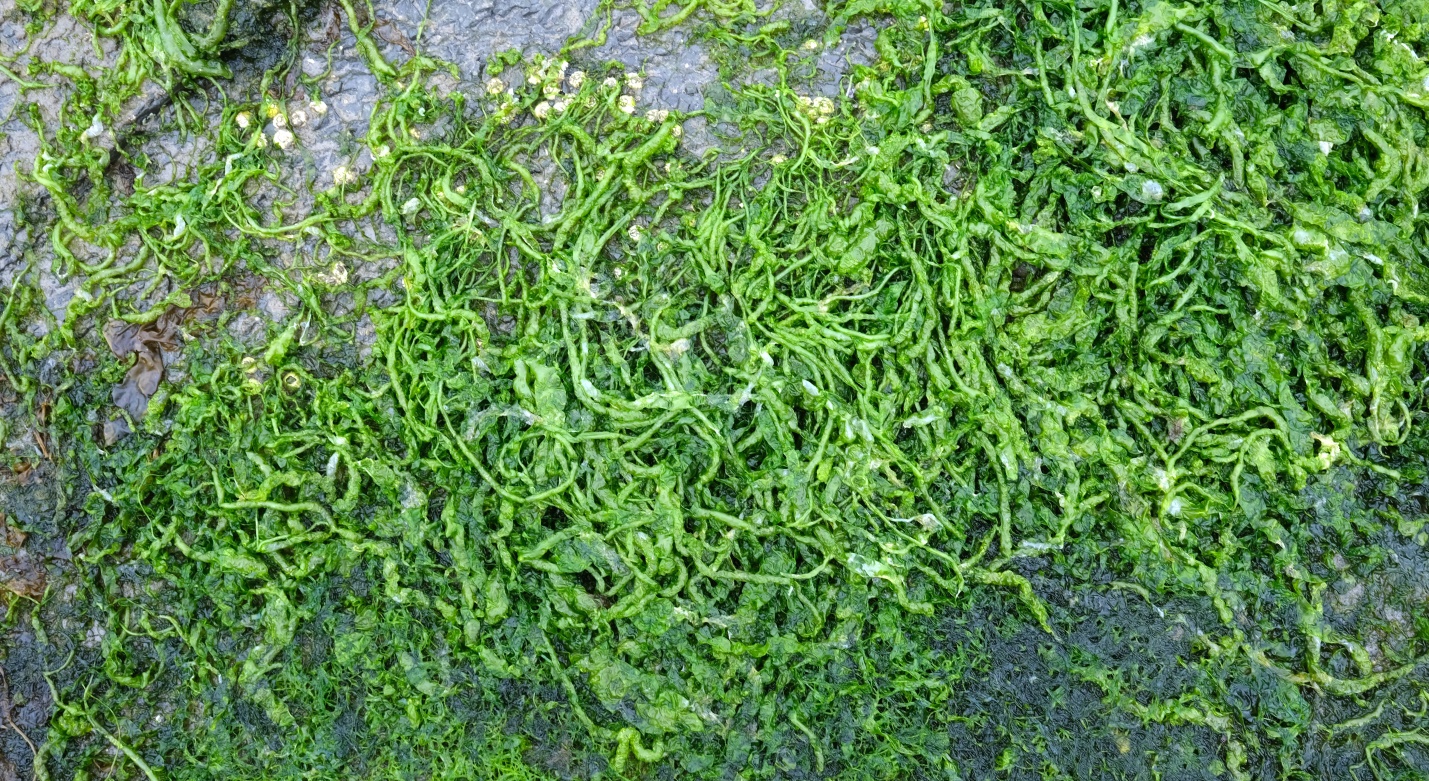
Figure 1: Ulva intestinalis – a patch of Gut Weed growing on the rock shelf; Comox Bay, Strait of Georgia, B.C., Canada. April 10, 2022. Photo ID: 27129 ©Seaweedwhisperings.com
Person 1:
Brooklyn Creek Observations –
Long and gracefully flowing with the gentle stream.
Enjoys going with the flow.
Young salmonids amongst them seem to move in unison with the Ulva.
Does Ulva intestinalis like to fit in with the crowd?
My printing of “ULVA” looks more like “VIVA”. I see lots of ‘life’ in these streambed clusters.
Closer examination reveals that the blades form irregular, almost tube-like structures (up to 8mm in diameter and the very longest was 1 meter in length; most were about 35 to 40 cm in length). Conduits? To what? From what?
These clusters are thriving in brackish water, occasionally totally covered by salt water, but flushed by fresh stream water ever day in the growing season.
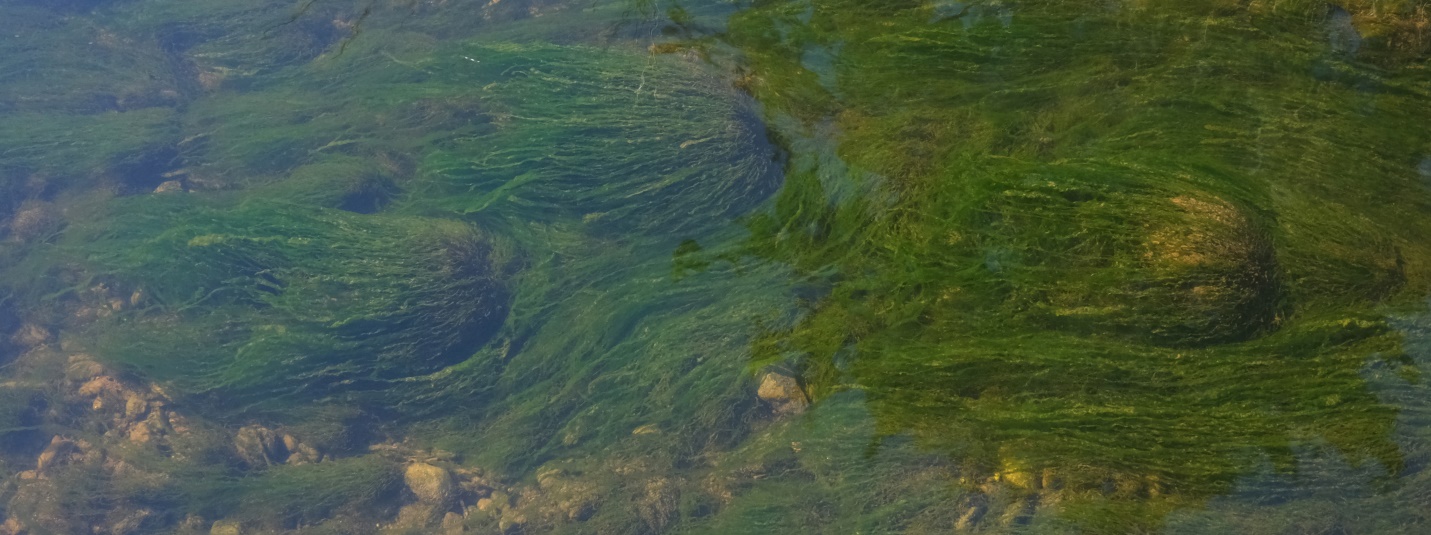
Figure 2: Ulva intestinalis wafting in the gentle seaward flow of Brooklyn Creek. If one imagined each large cobble to be a head, then Ulva intestinalis does indeed resemble ‘Sea Hair’ and the style to be actually ‘cornrow’; Comox Harbour, B.C., Canada. April 11, 2022. Photo ID: 27128 ©Seaweedwhisperings.com
Person 1 (continued):
I’ve seen you in areas that have much less favorable growing conditions.
You are quite adaptable, provided you have at least a seep of freshwater.
In relatively calm pools you can grow in exquisite curled patterns.
In places where growing is tougher you are content to simply form small tubes (1mm diameter and only a few centimeters long).
Your bright green coloration adds cheer to the intertidal seascape.
You are unobtrusive. No one really notices you, nor are they drawn to get to know you better. You are simply part of the background.
What would happen if you disappeared? Would anyone notice?
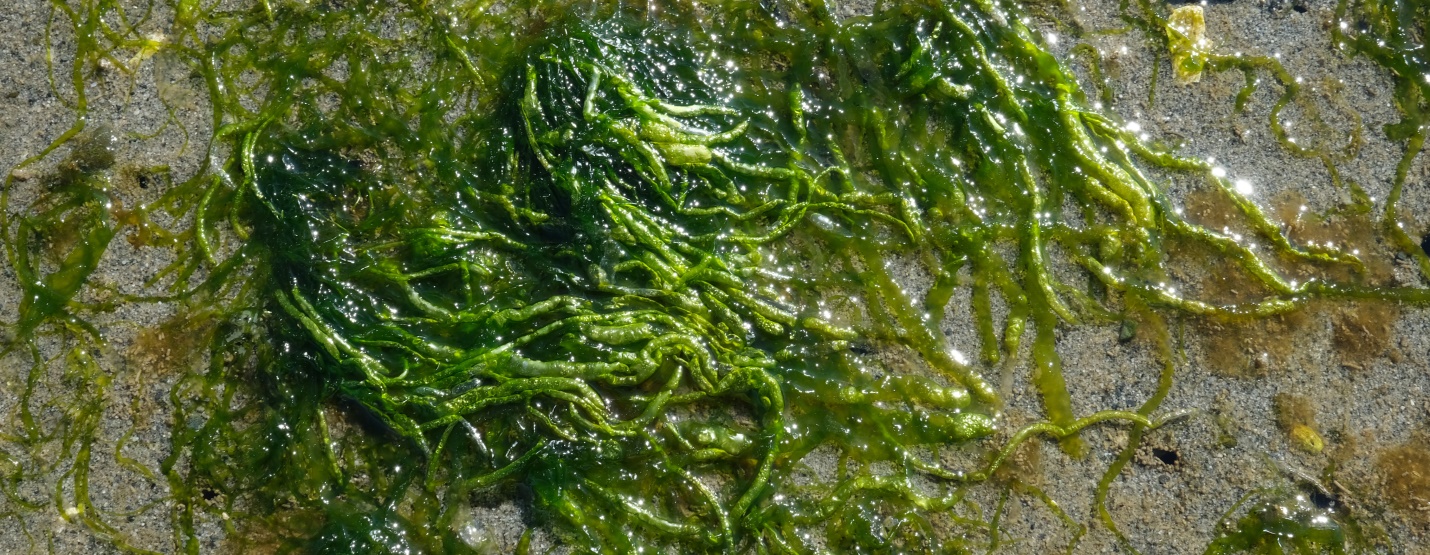
Figure 3: Ulva intestinalis – a patch of Ulva growing in the high intertidal adjacent to the salt marsh. These algae are still enjoying a bit of freshwater seep and many of the ‘green tubes’ are inflated looking – this reveals the variation in size and shapes and contortions of this alga; Brooklyn Creek Estuary, Comox Harbour, B.C., Canada. April 11, 2022. Photo ID: 27130 ©Seaweedwhisperings.com
Person 2:
Headed out to the intertidal zone to interact with this seaweed and as we crossed the bridge over Brooklyn Creek we stopped and looked down to the water. There were numerous cobbles each covered with Ulva intestinalis, long green tubes, wafting in bumpy, wavy lines, downstream. Growing in the freshwater. Yes, unusual for a seaweed.
And hiding, looking only like beige/grey wiggly segments, were hundreds upon hundreds of tiny salmonids.
This creek is a good safe home for both algae and salmon fry.
Good and SAFE.
Safety in movement, wiggly, wafting, wavy tendrils; always moving or making a curve.
Your green is striking. It stands out, this green of yours.
A bright green.
Cheerful!
Noticeable – especially up at the higher intertidal areas where little else of algae-types grow.
Does this green shout out, “Notice me!”, or “Look at me!”
Or, does it reveal how “green” you are – very young in terms of maturity.
Inexperienced.
The phrase comes to mind, you’re so new you’re “still wet behind the ears”.
Even out of water, at least if freshly stranded, your tubes of green that are widely varied where they’ll bend or flatten or constrict, the tubes of green are still lively looking.
You’d prefer to wiggle and shimmy in the water, but you’ll get by here for a time.
Looking at the base of your thalli, I find it difficult to observe your holdfast; it must be very small. It is interesting to think about this, because while I don’t think you are very ‘firmly rooted’ as individuals, as a species you are an algae that I encounter almost at any season and at nearly every intertidal region I visit – an odd juxtaposition!
I have seen you in summertime – rimming high tide pools that have gradually evaporated and also when freshwater seeps have dried up. That is too much! You seemingly die, leaving a tangle of flattened tubes that are bleached almost white. Somehow even in death, you stand out – saying yet again, “Look at me”.
When I’ve looked up close at you floating in a pool of water, salt or fresh or some combination of both, I have the feeling that you look rather ‘weird’, as in otherworldly – almost like a half-alien life form.
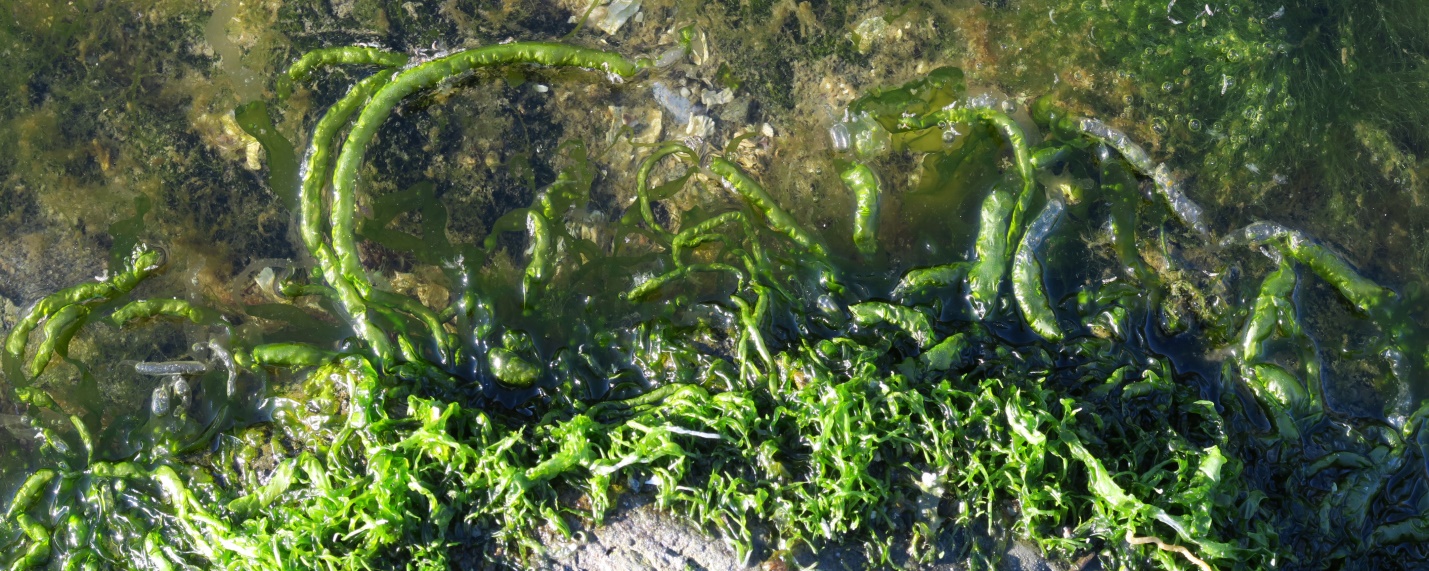
Figure 4: Ulva intestinalis viewed close up at the edge of a high intertidal pool; Gonzales Bay, Juan de Fuca Strait, March 9, 2022. Photo ID: 27131 ©Seaweedwhisperings.com
I wonder what’s going on in those tubes of green…?
Some experiment…?
I have the awareness of an aspect of ‘entrapment’. Like ‘alien’, the word ‘entrapment’ seems a bit odd, but the energy is there and it fits.
Is this seaweed trapped?
Or does it do the trapping?
Or both?
Lost to wander…, endless green twists and turns that are none identical and yet all basically leave you with the same result – lost within a green tube.
You’re not learning much this way, or yet.
And how does that feel? Frustrating, maybe even angering.
Like your movement in the creek reminded me of the wiggles of tadpole tails – you’re far from ‘adult’; you’re an early and essential part of the journey to adult, but you’re not meant to yet be an adult.
One can find you way up high on the shoreline, close to the terrestrial plants and forest edge, there are patches of bright, bright green, proliferations of wiggly tubes – one asks, “What is that?”
You wouldn’t immediately think of seaweed.
It’s so far (relatively speaking in comparison to where other seaweeds grow) from the sea.
Are your green tubes open or closed? This is the question that gives a clue as to how this person can best feel.
Open – exploring and questioning and moving round the next curve feels good.
Closed – going nowhere, recirculating what you already know/believe, becomes dark, stuck, sometimes toxic and self-destructive.
High up in the intertidal or supratidal zones, you have one foot in the realm of freshwater plants and the other foot in the realm of marine macroalgae. Are you, Ulva intestinalis, still exploring and trying out both?
But if you are doing so, it does seem that you are also stuck, as if there is some rather large uncertainty that confounds you.
Maybe opportunities pass you by because you can’t make up your mind, Ulva intestinalis; you can be possibly too hesitant, indecisive, unsure.
Stools/feces – several movements rather that one complete; size was thinner, pieces floated in toilet water in formed with bends my intestines still intact – as if a plaster mold had been made of them.
Stools, in bits and pieces, with what felt like spaces that were ‘pockets of gas’ in between.
Learning about this seaweed in this interaction came in bits and pieces, too.
Bowel function; there can be the problem of an inability to ‘move waste out’ successfully. Sometimes there is only the passage of ‘gas’, which seems to take up quite a lot of space, but this is not what fundamentally needs to be cleared. Put another way, there can be an inability to ‘move and progress in one’s own beliefs’ in life; sometimes there is only the expression of ‘emotion’, which can be rather dramatic and take up a lot of space. The drama however rarely clears anything, quite the opposite, it adds to the entrenched self-beliefs.
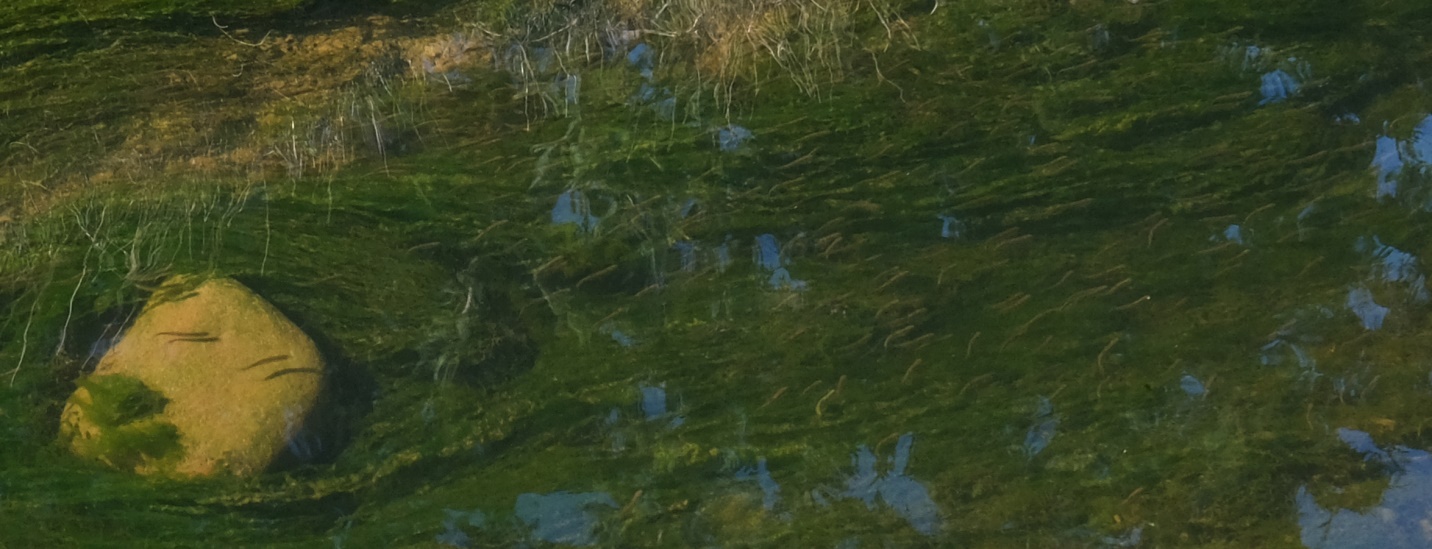
Figure 5: A moment of orientation is required to recognize what is pictured here; Ulva intestinalis is the fresh water loving alga that is creating the textured strings of flowing green; strands of blonde grass and patches of blue sky are reflected on the surface of the creek; and small wiggles of beige or grey looking ‘commas’ (some with shadows seen on the beige rock to the far left) are all oriented upstream – these are young salmonids finding safety in camouflage among the macro algal vegetation. Brooklyn Creek, Comox Harbour, B.C., Canada. April 11, 2022. Photo ID: 27132 ©Seaweedwhisperings.com
Discussion:
After two years of fairly focused activity interacting with numerous seaweeds we came to you now, Ulva intestinalis. It wasn’t that we had been ignoring you; in fact we’d note your presence at almost every visit to the seashore. Looking back we had the sense that there was no hurry and also we did not have the sense you had much to share with us. Do you withhold? Is whatever you might share with others trapped inside? It may be withheld or trapped inside your green tubes, but this has the effect that often others don’t think it’s worth pursuing because there’s simply nothing much of interest evident there. Another possibility here is that Ulva intestinalis is overly self-absorbed and as such they don’t reach the point of considering sharing. Again, this generally doesn’t attract others, and so Ulva intestinalis often remains outside community.
Alien - not quite from the sea, not quite of the land.
Do you feel like an alien?
Perhaps ‘alien’ is a bit of a strong word, but for some reason I want to use it rather than ‘foreigner’ or ‘nonnative’ or ‘stranger’.
Wet behind the ears – bright and green a cheerful, but “oh boy, they’ve got a lot to learn yet!”
Endless questioning – like a toddler, a two year old.
Do you prefer to have access to someone who can give you the answers?
It seems maybe you feel a bit unable to go after finding the answers yourself.
You sometimes can be lively and playful at this, but you also can be very unsure and hesitant to draw any conclusions.
Questions, yes, unanswered questions, you have many of these, and they seem to surround you, Ulva intestinalis.
Young and needs safety and time to be able to mature… like the salmon fry.
Ulva intestinalis certainly doesn’t try to hide or conceal its presence. It may, however, remove itself from most predation by where it grows.
What does Ulva intestinalis need in order to feel safe? It seems there is a hiding within that goes on and the question of safety is something that this person wrestles with to some degree almost all the time – relative degrees of feeling at ease and safe, and of also then of repeatedly bumping up against a feeling of no safety. Without that safety, nothing else goes on much at all, let alone goes on well.
So obviously it has found some degree of safety because it exits and is in areas often prolific. Then what else, what else does any life form need beyond safety?
It needs nourishment.
Well the places that Ulva intestinalis has found to be ‘safe enough’ come with other issues.
Ulva intestinalis can and often does live way up on the fringes of the high intertidal, even in the supratidal zone (the area above the spring high tide line of estuaries and coastlines, the supratidal is regularly splashed but not submerged by ocean water). Or this macro alga lives in areas very much fed by freshwater seeps. These seeps aren’t always so “fresh”, and can be quite acid.
So, nourishment can become an issue as well as safety.
Hierarchy of human needs:
The first is for safety.
The second for shelter, water, food.
And the third is for love.
The needs vary in their complexity from person to person but the basics remain the same.
Ulva intestinalis has picked a place to live that quite nearly no one else wants.
One consequence of this ‘poor’ place is it is deficient in “shelter, water and food”.
How is it for love, we wonder…? Is that deficient, too?
Entrapment – that point bears some reviewing. We looked up synonyms of the word ‘entrapment’ as it is one that does not come to mind often and found related words that included capture, trap, ambush, inveiglement, deception, trick, and even strangulation and asphyxiation. This is remarkable, because when I observed the individual tubes of this seaweed I saw trapped air bubbles, and I wondered about how the ‘atmosphere’ in those hollow tubes must change as the temperature rises and anything within the tube was trapped there.
There was a lingering feeling about this Whispering; it was as if we’d made a good enough connection but also that we feel didn’t discover much, didn’t quite learn much. In retrospect, a fair bit was learned with this interaction, but the feeling is that that is not happening. You have to really ‘dig’ to get anything, and there’s not much motivating one to do that. This feeling goes back to the “not much of interest here” noted earlier.
The “intestinalis” species name makes one think of the digestive system, and it seems with this seaweed there can be a scarcity of anything to digest. Sometimes they’re just “full of air”, or full of not much at all. Maybe the “hollow” of the tube, the space with nothing in it, is as much who they are as the ring of single green cells that forms the tube.
Perhaps, though, ‘not learning much’ is related to living in a resource poor area. Not much is available to “feed” them. Ulva intestinalis can get very little of “mother sea” and certainly not as a consistent source of nourishment, and freshwater seeps are often acidic and may be good for hydration but possibly are also lacking in suitable nutrients. At times they won’t get any saltwater for days, unless there is a big storm. In order to learn, grow, experience, progress, one must have “material” to work with. Possibly Ulva intestinalis is chronically missing this.
They’re in a barren or resource poor situation much of the time.
Therefore they flounder.
They’re not getting much ‘input’ at all, so they don’t know and don’t learn newly what to do.
They can get stuck and unable to move beyond, unable to think about other possibilities.
Stuck, floundering, nothing goes anywhere or it just goes around and around in the same morass…, that’s the darker/toxic state. There’s an old adage, “don’t get stuck in the abyss of your own morass”. It seems like Ulva intestinalis can go there and get trapped there.
There is a benefit also to the aspect of going around and around. This can be a good and useful thing, as long as one doesn’t get ‘trapped’ in that. It can be the positive ability to revisit something and with that second ‘visit’ you have the opportunity to see if you can do better.
“Would anybody notice if it was gone…?”, Person 1 asked, earlier of Ulva intestinalis’s existence. This is a sentiment that can be felt by persons in a very dark personal place who consider suicide, “Would anybody notice if I was gone?” The sentiment Person 2 noticed of how this algae can have “look at me!” energy, this is, like the suicidal ideation above, another very self-centered/self-focused point of view. Is it hard for this type of person to see outside of their own “tube”? They’re not so much ‘selfish’ but rather they’re often not able to cope with what is going on within, much less to add on what is going on with others.
Floating in gentle waves of green tubes, Ulva intestinalis was truly content in the waters of Brooklyn Creek. It is a fact that this alga will certainly tolerate and endure harsher settings, but in the waters of the creek it grew to maximum lengths and was very healthy. It seemed that this is ideal for Ulva intestinalis, to have the ever present direction and guiding force of the creek. It is almost as if there can be a lack of will or individual determination or chosen direction and so there is therefore a need for, and a relief in, simply responding and going with the flow – going with the flow in accord with some outer and stronger influence.
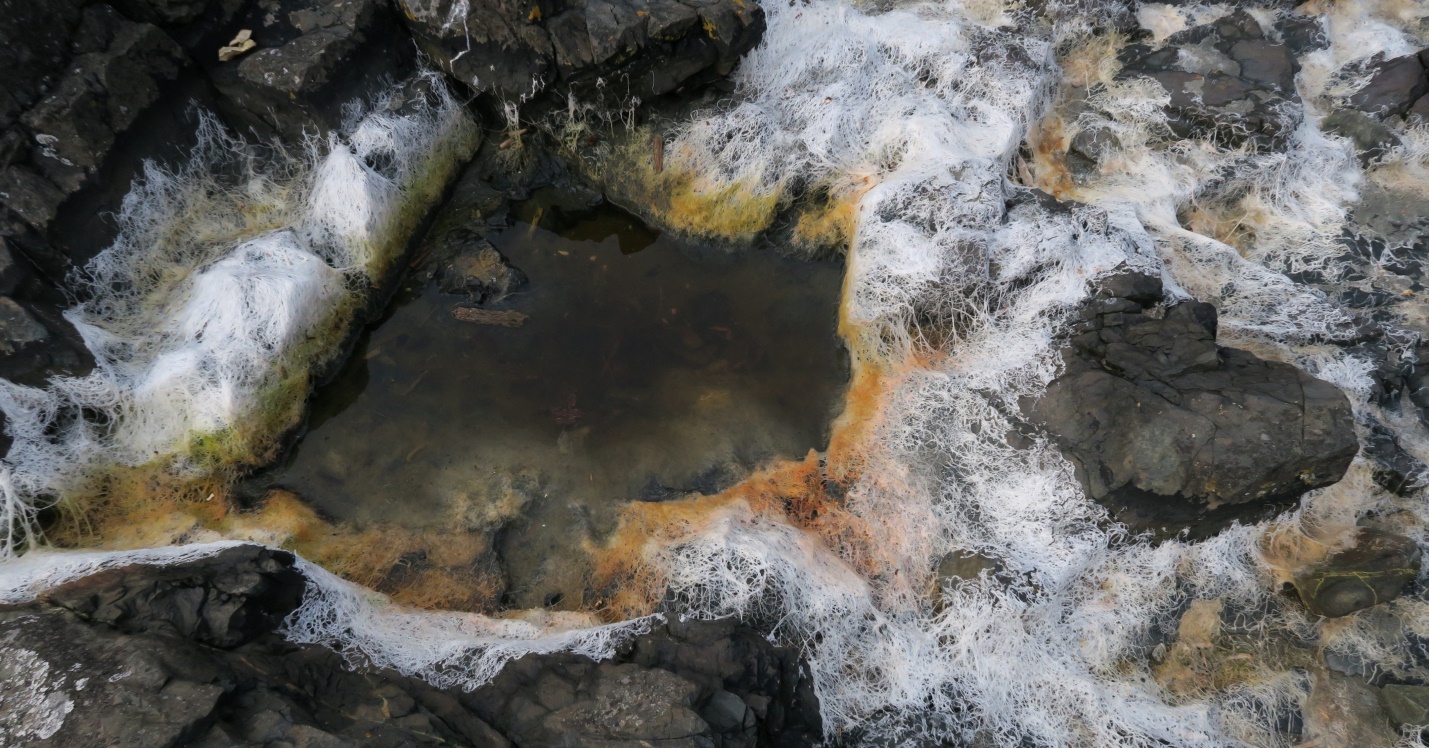
Figure 6: The tide pool pictured here measured about 3 meters across on this warm summer day. Located high above the high tide line, the winter storms had long stopped any ocean spray to this region and the terrestrial seeps had been dry for many weeks. The white ‘life form’ rimming and within the pool is Ulva intestinalis. Fishboat Bay, Juan de Fuca Strait, B.C., Canada. August 21, 2021. Photo ID: 27133 ©Seaweedwhisperings.com
Biology & Natural History Information:
Description:
Thalli of this common green alga from bright green to pale green hollow tubes that grow from a small holdfast. Their length is normally to 20cm and occasionally as long as 1 m. The tubes will grow up to 5mm in width, tend to widen at their tips and are constricted/pinched at irregular individuals resembling intestines. Groups of individual tubes are almost always found growing in clumps and can from dense mats. Coloration becomes yellow when reproductive and the tubes will bleach to white after prolonged sun exposure.
Habitat/Bathymetry:
Ulva intestinalis grows on rocks, although can grow free floating in protected areas, and is often found in high intertidal tidepools or in areas of brackish water or near freshwater seepages even well above the high tide line.
Distribution:
This seaweed is cosmopolitan in temperate coastal regions; Bering Sea and Aleutian Islands, Alaska to Mexico; Korea; Japan; Russia; Chile; Mediterranean; Atlantic; North Sea; Baltic; Australia.
Remarks:
In spite of the seemingly fragile construction, tubes that are only one cell layer thick, this species of green alga can grow not only in many parts of the world but it also can tolerate extremes of salinity. It can thrive in tidepools that remain unrefreshed by the sea for extended periods of time that become increasingly salty as evaporation occurs. It also can grow, as was the case at Brooklyn Creek, in areas of freshwater run off and seepages.
This species was formerly known as Enteromorpha intestinalis, but has recently been placed back in the genus Ulva, where it was originally placed by Linnaeus in 1753.
Classification:
Phylum: Chlorophyta
Order: Ulvales
Family: Ulvacea
Genus: Ulva
Species: Ulva intestinalis Linnaeus 1753
Previous names: Enteromorpha intestinalis (Linnaeus) Nees
![]()